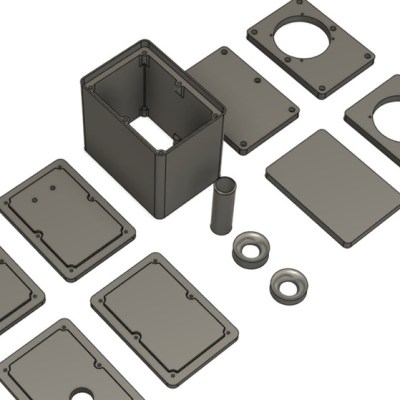Having the right speaker enclosure can make a big difference to sound quality, so it’s no surprise that customizable ones are a common project for those who treat sound seriously. In that vein, [zx82net]’s Universal Speaker Box aims to give one everything they need to craft the perfect enclosure.
 The parts can be 3D-printed, but the design ensures that the front and back panels are flat, so one can use wood or some other material for those depending on preference and appearance. The assembly is screwed together using six M3 bolts per side with optional heat-set inserts, but it’s entirely possible to simply glue the unit together if preferred.
The parts can be 3D-printed, but the design ensures that the front and back panels are flat, so one can use wood or some other material for those depending on preference and appearance. The assembly is screwed together using six M3 bolts per side with optional heat-set inserts, but it’s entirely possible to simply glue the unit together if preferred.
One thing that makes this design a bit more broadly useful is that [zx82net] not only provides the parametric design file for Fusion360, but also includes STEP format CAD files, and a small number of pre-configured assemblies for a few commonly available speaker drivers: the Dayton Audio DMA70-4, ND91-4, and the TCP115-4. Not enough for you? Check out [zx82net]’s collection of ready-to-rock enclosures in a variety of designs and configurations; there’s bound to be something to appeal to just about anyone.
[via Reddit]
















Would be better in OpenSCAD, and I don’t see anything too complicated to replicate.
+1, out with fusion360 pls
Someone did something really clever and useful and shared it with everyone for free.
What a terrible shame they didn’t do in your favourite program.
licensing is a valid qualm
If you had been paying attention, the reason is that Fusion 360 is not Free.
I’m also not a big fan of the subscription model for professional use, but there is a completly free license with some minor drawbacks, how is this not free? Ok not open source and everything, but it’s free and really good at it.
Fusion 360 is absolutely free for private and educational use.
You only need a paid license if you use it for professional/business actions. In that case you should be able to convert it or simply recreate this super simple design within an hour. if you can’t do that, chances are that you are less professional than you think.
@Alex365
It might be “free as in beer [1]”, but it ain’t “free as in speech”.
If you’re around here, you should try to understand that difference. It’s basic engineering knowledge.
[1] Yeah, that’s the standard term. More fitting, IMO, would be “free as in getting hooked”.
Wow, when I saw the Hackaday headline I just ASSUMED it would be in openscad, because that’s the better tool for the job.
Oh well, hopefully this proof of concept will inspire someone to do exactly that!
It’s nice to see that the field has moved on since the old days when we had to work everything out in longhand on paper. And calculate the thiele-small parameters of the drivers by sticking coins on the cones. In the snow, barefoot :-)